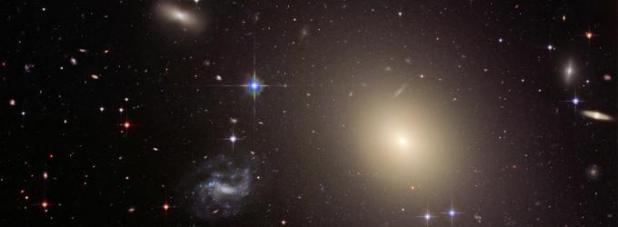We reach more than 65,000 registered users in Dec!! Register Now

Harvard astronomers found 'runaway' galaxies
- May 02, 2015
- 1050 Views
- 0 Likes
- 0 Comment
We know of about two dozen runaway stars, and have even found one runaway star cluster escaping its galaxy forever. Now, astronomers have spotted what they call entire runaway galaxies. These islands of stars are leaving the galaxy clusters where they originally formed, having gained enough speed to overcome their gravitational ...
We know of about two dozen runaway stars, and have even found one runaway star cluster escaping its galaxy forever.
Now, astronomers have spotted what they call entire runaway galaxies. These islands of stars are leaving the galaxy clusters where they originally formed, having gained enough speed to overcome their gravitational clutches. The 11 newfound runaway galaxies are expected to end up wandering the void of intergalactic space.
They're “facing a lonely future,” quipped astronomer Igor Chilingarian of the Harvard-Smithsonian Center for Astrophysics in Cambridge, Mass., and of Moscow State University. Chilingarian is the lead author of the study, which appears in the research journal Science.
An object is designated a runaway if it's moving faster than “escape velocity,” which means it will depart a home base never to return. In the case of a runaway star, the required speed is more than a million miles per hour (500 km/s). A runaway galaxy has to race even faster, traveling at up to 6 million miles per hour (3,000 km/s).
Chilingarian and co-author Ivan Zolotukhin initially set out to find new members of a class of galaxies called compact ellipticals. These tiny blobs of stars are bigger than star clusters but smaller than a typical galaxy, spanning only a few hundred light-years. In comparison, the Milky Way is 100,000 light-years across. Compact ellipticals also weigh 1,000 times less than a galaxy like our Milky Way.
Before the study, only about 30 compact elliptical galaxies were known, all in galaxy clusters.
To find new ones, Chilingarian and Zolotukhin sorted through public archives of data from the Sloan Digital Sky Survey-a project to map the universe involving many institutions-and from a NASA satellite known as GALEX.
They identified almost 200 previously unknown compact ellipticals, of which 11 were isolated and far from any large galaxy or galaxy cluster.
“The first compact ellipticals were all found in clusters because that's where people were looking. We broadened our search, and found the unexpected,” said Zolotukhin, of the Institute for Research in Astrophysics and Planetology in Toulouse, France, and Moscow State University.
The isolated compact galaxies were unexpected because theorists thought they originated from larger galaxies that had lost most of their stars because of interactions with an even bigger galaxy, the scientists added. So, the compact galaxies should all be found near big galaxies. But not only were the newfound compact ellipticals isolated, they were also found to be moving faster than their brethren in clusters.
“We asked ourselves, what else could explain them? The answer was a classic ‘three-body interaction,'” said Chilingarian. What does that mean? A star can be kicked up to a tremendous speed if, along with a partner star, it wanders close to a giant black hole, a center of overwhelming gravity. In the resulting gravitational interactions, the hole will swallow up one star and throw out the other.
Similarly, a compact elliptical could pair up with the big galaxy that stripped it of its stars, Chilingarian said. Then a third galaxy blunders into the dance and flings the compact elliptical away. As punishment, the intruder ends up stuck as part of the remaining big galaxy.
The discovery represents a success of the “Virtual Observatory,” he added-a project to make data from large astronomical surveys easily available to researchers. So-called data mining can result in finds never expected when the original data was collected. “We recognized we could use the power of the archives to potentially unearth something interesting, and we did,” said Chilingarian.
Source : www.world-science.net









